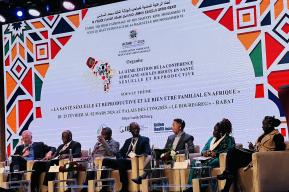Article
Why youth leadership is central to efforts to prevent school-related gender-based violence

Schools are meant to be safe havens, where children meet friends, socialize and learn how to shape their futures. Yet 246 million learners experience violence in and around schools, seriously hampering their education, and their physical and mental health.
Every month, one in three learners is bullied at school globally. And almost one in three has been physically attacked at least once in a year. Amid its different forms, school violence is often rooted in gender inequalities. Global data shows that one in four young women has already experienced violence by an intimate partner by the time they turn 24, indicating the presence of gender-based, or sexual violence, among school-aged children.
If violence against women and girls is normalized in the home or within a society, it runs the risk of being normalized in schools too. Education has the power to break that cycle. And young people are taking an active stance on this issue.
Read about youth’s insights and drive to take a central role in efforts to prevent school-related gender-based violence (SRGBV).
Why is ending SRGBV key to learning, and to children and young people?
SRGBV exists in supposedly safe spaces for learners, places of learning. It hampers our ability to acquire knowledge, life skills, enjoy school life, and build the best versions of ourselves.
But we, as young people, are the ones directly affected by this invisible pandemic and therefore with most at stake. We must take a central part in building sustainable solutions and ensuring these solutions are effective and cater to needs across the physical, mental, and emotional aspects of their lives and learning.
How can young people be effective actors in ending SRGBV?
Children and young people can contribute innovative ideas and have made calls to prioritize re-evaluating of schools’ safeguarding guidelines, strengthening protection and prevention mechanisms, and ensuring learners and adolescents have the agency to speak up for themselves.
Fostering a collective practice where the knowledge being curated is not coming from the “adults” in the room but a shared ownership of narratives from across sectors is important. Making SRGBV action local can empower and unleash the agency of youth activists to take our place as key actors in ending SRGBV. We are already the first responders in schools and communities, and this means we are well aware of the needs, social and gender norms and challenges.
What does intergenerational partnership look like to end SRGBV?
It would focus on “collaboration” to gather gender-disaggregated data in national and subnational levels. This means working with students and youth-led organizations, sharing resources and good practices, and co-creating strategies together.
Listening to young people needs to happen. Ending SRGBV requires a “whole school” approach that is inclusive and mindful of every learner’s thoughts, ideas and actions in designing solutions and actions.
What are your hopes and the way forward recommended by youth?
It takes more than learning from each other to make a difference. We must build a community of practice looking at what actions are being taken, and what we, learners and young people, stand to gain from these actions, how to empower youth to take up our space and assert our capabilities to address SRGBV as it is happening within our own contexts.
It is our hope that young people are more included at all levels of consultation, convening and engagement on data and analyzing evidence. We are activists at the forefront of advocating the use of a gender lens to ensure focused, inclusive, collective data and evidence representative of our lived experience.
We need a gender-transformative approach, breaking down harmful gender stereotypes, understanding the key roles not only ours as youth, but also the roles of teachers, school administrators, stakeholders, and governments to be able to achieve a safe and equitable learning environment that each learner and young person deserve.
UNESCO thanks the contributions from Transform Education (TE) to this article, highlighting the voices of youth who participated in a Learning symposium on SRGBV hosted by UNESCO and UNGEI under the aegis of the Working Group to end SRGBV. TE, a coalition of youth-led networks and young activists hosted by longstanding UNESCO partner, UNGEI, has been an essential convening partner in highlighting the significance of youth leadership in SRGBV action.
As co-convenors of the Working Group, UNESCO and UNGEI have launched a new brief entitled: School violence: Why gender matters and how to measure school-related gender-based violence.









